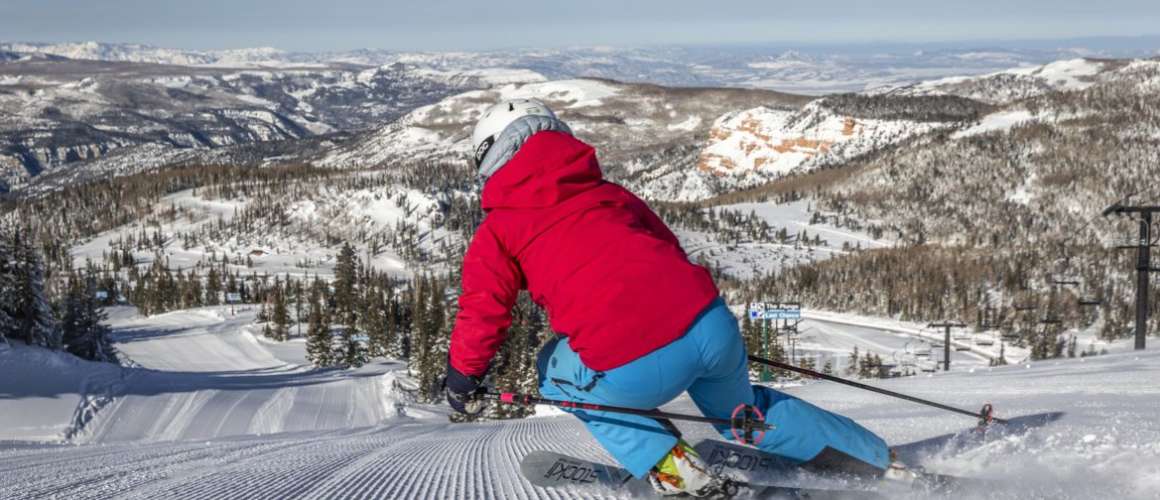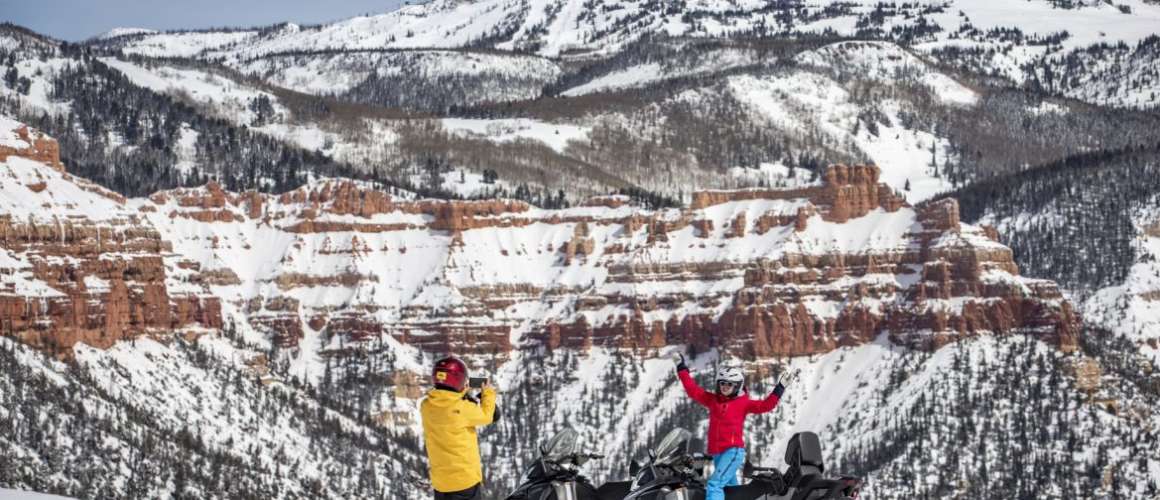Snow Activities
Ski and Snowboard
When the temperatures drop and snow falls, the winter just heats up with skiing and snowboarding in Southern Utah. Utah is famous for having the “Greatest Snow on Earth” and we are fortunate to have a ski resort here in the heart of the red rock country of Southern Utah — Brian Head Resort.
While Brian Head has gone through some major renovations to modernize their amenities, they still take an old-school approach to running the mountain. This place has everything you want out of a Utah ski resort: the same dry Utah powder as her sisters to the north but with ticket prices that don’t break the bank. Brian Head is a mellow ski resort where everyone knows your name and you’re treated like family — minus the weird uncle and the head noogies.
Brian Head Resort receives over 400 inches of famous Utah powder every year and features Utah’s highest base elevation at 9,600 ft. with a lift-served vertical drop of 1,320 ft. from Giant Steps. With renovated lodges, new tubing hill, new night skiing options, and magic carpet surface lifts, Brian Head has improved the overall experience. The resort offers over 650 acres with eight chairlifts and 71 runs. Take flight with revamped terrain parks that offer countless features for all skill levels. The Training Grounds Terrain Park consists of over 20 features for all skill levels with a dedicated park crew for the two progressive park areas, allowing you to improve your park skills with a state-of-art set up.
Amidst a stunning alpine backdrop, Eagle Point offers five lifts with access to over 400 skiable acres and 40 runs ranging from easy groomers to some of the most challenging runs in all of Utah. For more adventure, check out the 18-foot half pipe, freestyle terrain, and tubing park. Powder enthusiasts — don’t miss some of the best backcountry in Southern Utah’s Fishlake National Forest. As a courtesy for guests, Eagle Point, in cooperation with the National Forest Service, offers specific locations where skiers and riders can access the Fishlake National Forest backcountry.
Brian Head Resort’s Ski School
Whether you want to learn to ski or snowboard, friendly instructors help you get the most of your experience. Utilizing Terrain Based Learning™ with shaped and sculpted snow makes learning the sport easier, quicker, and more fun. The resort offers children and adult programs as well as private lessons. Advance reservations highly recommended and required during holiday periods.
Night Skiing & Boarding at Brian Head Resort
Most weekends and holidays the lift at the Brian Head Resort Navajo Mountain Learning Center opens for night skiing and boarding. The lighted runs of “Pioneer Chair Lift #6” give you a new perspective of Brian Head Resort. Rates are pretty affordable, usually less than $15 and equipment rentals are also available reduced rates.
Distance from Cedar City
31 miles
More Info
Brian Head Resort
PO Box 190008
329 S. Hwy 143
Brian Head, UT 84719
(435) 677-2035
(866) 930-1010
www.brianhead.com
Cross-country Skiing and Snowshoeing
Some of the nation’s best snow conditions occur year after year in the mountains east of Cedar City. The snow conditions and terrain on Cedar Mountain, including Dixie National Forest and Cedar Breaks National Monument, are some of the best in the country for cross-country skiing and snowshoeing.
Located 22 miles from Cedar City off Highway 14, Dixie National Forest’s Deer Hollow is ideal for cross-country skiing, snowshoeing and fat biking. There are nearly 37 kilometers (23 miles) of groomed cross-country ski trails, with loops designed for every level and type of skier, and more than 2.5 kilometers (1.6 miles) of snowshoe and fat bike trails on the east side of the recreation area that lead you to the stunning Lava Field and Navajo Lake Overlooks. For a PDF of the Deer Hollow Winter Recreation Area click here.
Cedar Breaks National Monument is also a fave for cross-country skiing. Park at the junction of Highway 143 and Highway 148, then follow the groomed trail for spectacular views at the Chessman Overlook. Stop at the warming yurt (weekends only) for hot cocoa and conversation with a park ranger. Cedar Breaks’ staff also offers free guided snowshoe hikes every Saturday throughout January and February.
Safety Tips
- Advise someone of where you are going and the time period you expect to return.
- Make sure to always wear clothes in layers, which enable an individual to adapt to changing weather conditions.
- Check weather and avalanche danger forecast before setting out on a ride.
- Don’t harass the wildlife!
Extreme Conditions
Frostbite
Hopefully you will never have to experience frostbite, but if it should set in, you should know how to spot it. Frostbite is caused by exposing unprotected flesh to freezing temperatures for a prolonged period of time. Those body parts that pose the most risk are your fingers, toes, nose, and ears. The damage occurs when the flow of blood to these parts is reduced. The symptoms of frostbite are loss of feeling and a dead white appearance. To treat frostbite you need to restore the body’s temperature as quickly as possible by providing heat externally. This may include such things as a hot water bottle, a campfire, or immersion in water baths with a temperature less than 110 degrees. The affected body areas must be covered immediately. Make sure not to rub, vibrate, or apply pressure to the affected areas. Snow or cold water should not be applied to the frostbitten areas.
Hypothermia
Hypothermia poses the greatest danger to winter enthusiasts. This happens when the body loses heat faster than it can produce it, draining energy from the body. The main way to prevent hypothermia is to wear layered clothing. The factors that contribute to hypothermia are cold weather, wetness, wind and the wind chill factor, and exhaustion. Symptoms include uncontrolled shivering, fumbling hands or stumbling walk, vague or slurred speech, memory lapse, drowsiness and apparent exhaustion. The treatment of hypothermia begins with removing the victim from the harmful environment that caused the condition. This may be achieved by setting up a shelter or moving to a timbered area. From here, proceed to remove the individual’s wet clothing and place them in dry clothing or a sleeping bag. Added warmth may be achieved by getting in the bag with the person. If warm liquids are available, give them to the person, but never give them alcohol. If the victim is conscious, give them sugary foods that can provide them with a quick energy fix. Try to keep the person dry and warm and seek medical help as soon as possible.
Avalanche Danger
If you are caught in an avalanche you should immediately call out to others in hopes that they can see your course. It is very important to stay calm. Make an attempt to move away from your equipment and machine. Try to swim with the avalanche in an attempt to reach the side of it. Never swim against the avalanche. As you are coming to a stop, thrash your limbs about in hopes of loosening up the snow around you. Before coming to a stop, place your hands over your face to create an air pocket for breathing. If you are completely covered by snow the only way to gauge which way is up is to spit saliva and gravity will lead the way. Be sure to dig up. If you survive an avalanche, don’t desert the other victims. Stab your pole into the snow directly downhill from the point they were last seen.
The new statewide telephone number for avalanche forecast updates is (888) 999-4019 or go to the Utah Avalanche Center website.
Plan Your Trip
Brochure
Cedar Mountain Nordic Ski Map
More information
Cedar Mountain Nordic Ski Club (CMNSC)
A nonprofit group formed for the purpose of promoting cross-country skiing in the Cedar City/Brian Head area and to educate the public about the benefits of Nordic skiing. Please visit CMNSC at www.meetup.com/cedar-nordic for trail descriptions and maps, or call.
Dorothy and David Uherka at (435) 867-4644.
Dixie National Forest
District Headquarters
1789 N. Wedgewood Dr
Cedar City, Utah 84720
(435) 865-3200
Snowmobiling
Utah has some of the greatest snow on earth and more than 850 miles of groomed snowmobile trails traversing from the red rock canyons of southern Utah to the rugged mountains of northern Utah. Whether you are a beginner, intermediate or expert rider, there are plenty of groomed trails to match your riding skills.
If you are not one for staying on trails, there are hundreds of thousands of acres of high mountain bowls of famous Utah powder snow. All can be accessed through Utah’s extensive snowmobile trail system.
Snowmobile Guidelines
- Ride on right side of the trail, giving the uphill-bound machine the right of way. Be careful not to follow other snowmobiles too closely.
- Use headlights and taillights in daylight and darkness.
- It is illegal to drive a snowmobile while under the influence of alcohol or drugs.
- Please park cars, trailers, campers, etc. in designated snowmobile parking lots.
- Check with local U.S. Forest Service offices for trail guides of ungroomed trails and other areas open to snowmobile use.
Safety Tips from the Utah Snowmobile Association
- Let someone know where you’re going and when you expect to be back. Never ride alone.
- Watch your fuel supply. Head out only to a point where the fuel gauge reads one-half; then follow your tracks back to the trailhead.
- An adult should accompany and supervise operators ages eight through 15 at all times.
- Dress for changing weather conditions. Layered clothing allows riders to adjust as temperature and weather conditions change.
- Be familiar with your machine. Know its fuel capacity and basic maintenance procedures. Carry spark plugs, drive belt, tool kit, and survival kit.
- Check weather and avalanche danger forecasts. Avoid potentially dangerous situations.
- Please don’t harass wildlife.
Cedar Mountain / East Snowmobile Complex
The Cedar Mountain Snowmobile Complex is one of the most scenic and exciting snowmobile areas in the nation with over 160 miles of groomed trails and epic play areas. Buzz through pines and aspens, kicking up piles of the fluffy white stuff in your wake. Incredible red rock views of Cedar Breaks National Monument and the Virgin River Rim zoom past. Trail info can be found at Utah State Parks & Recreation at (801) 538-7433, or for the latest Grooming Report visit stateparks.utah.gov. Stop at the Cedar City Visitor Center for a Cedar Mountain Snowmobile Complex brochure or download one here. Don’t own a snowmobile? Rent from a local outfitter, or even better, take a tour with a seasoned guide who’ll show you the sweetest spots on the mountain. For a list of local guides and outfitters.
CONTACT
Cedar City • Brian Head Tourism Bureau
581 N. Main
Cedar City, UT 84721
PHONE
(435) 586-5124
HOURS
Mon-Fri: 8:30 a.m. – 5:00 p.m.
Saturday: 9:00 a.m. – 5:00 p.m.
Sunday: Closed
Plan Your Trip
Brochure
Pick up a “Cedar Mountain Snowmobile Complex” map and brochure at any local visitor center or OHV dealer.
Visitor Center
Brian Head Town & Visitor Center
PO Box 190068
56 N. Hwy 143
Brian Head, UT 84719
(435) 677-2029
www.visitbrianhead.org
More Info
Utah Division of Parks and Recreation
1594 West North Temple
PO Box 146001
Salt Lake City, UT 84114-6001
(801) 538-7220
www.stateparks.utah.gov



